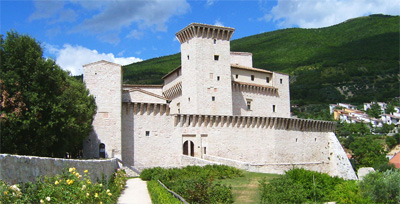Gualdo Tadino originated in the 12th century by refugees from ancient Tadinum, a city founded by the native Umbrian peoples. Primitively it stood in the plain below on the sides of the Via Consular Flaminia. A vast and flourishing city during the Roman period, it began to decline in the early Middle Ages due to the frequent looting to which it was subjected by the barbarians, whose dominion it suffered for a long time.
In 552 it was the scene of the famous battle between the general of the Greco-Roman Empire, Narses and the Gothic king, Totila, a battle in which the latter lost his life.
Half destroyed on that occasion, it increasingly declined under the harsh play of the Lombards, until in 966 it was finally destroyed by the soldiers of the German Emperor Otto III.
Resources not far away, around 1150, with the name of Waldam or Gualdo, but the danger of the place convinced the population to rebuild it in a safer position: thus, between the end of the 11th and the beginning of the 11th century, a new settlement arose in Valdigorgo or Valle di 5. Marzio.
In 1208 it placed itself under the protection of the nearby Perugian Republic with the hope of obtaining aid and protection, but in 1237 a furious fire completely destroyed it, apparently by a woman from the Nocerino countryside called Bastola, whose name has remained sadly famous. in local popular traditions.
The third and current Gualdo was rebuilt with the help of Emperor Frederick II who in 1239 arrived in this place from Lombardy and Tuscany with his splendid court and his numerous army.
In 1242, the emperor had a robust city wall built that embraced the entire city and rejoined the Rocca Flea; in it there were 4 gates (S. Benedetto, 5. Donato, 5. Facondino and 5. Martino) and 17 defense towers.
After the death of Frederick II in 1250, Gualdo again submitted to Perugia. In 1367, however, the militias of the Spanish Cardinal Gil Albornoz, on behalf of the Pope, brought it back under the dominion of the Papal State, but the following year it returned again under Perugian control. At the end of the 14th century, a sad period of political life began for Gualdo due to the continuous submissions to the Captains of Ventura who roamed Central Italy at that time.
In 1393 it was a possession of Biordo Michelotti, in 1403 of Ceccolino Michelotti, in 1416 of Braccio Fortebracci. In 1432 it was under the dominion of Corrado Trinci, Lord of Foligno. In 1433 the Pope granted jurisdiction to Francesco Sforza, Duke of Milan; in 1442 it ended up with Nicolò Piccinino.
Finally, in 1513, due to its strategic position between the State of the Church and the Duchy of Urbino, Pope Leo
In 1798, with the declaration of the end of the temporal power of the Popes, by the action of the French troops, it became part of the Roman Republic, in the Trasimeno Department, as the capital of the Canton, with its own Prefect and Municipality.
In 1814, taken over by the Church, it was assigned to the Apostolic Delegation of Perugia, in the district of Foligno, as the capital of government under a Governor.
In 1833 Pope Gregory XVI granted it the title of City with all honors and privileges and changed its name to the current Gualdo Tadino to distinguish it from other places and in memory of its primitive origins.
In 1849 it was incorporated into the Roman Republic, founded by Garibaldi and Mazzini.
In September 1860, General Cadorna entered Gualdo Tadino with Italian troops, thus forever sanctioning its union with the Kingdom of Italy.
Ruggero Guerrieri

